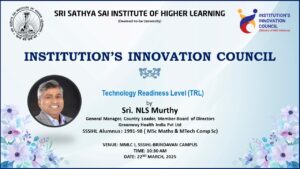
- This event has passed.
TRL: Maturing Innovation – By Sri. NLS Murthy

Technology Readiness Levels (TRL): Maturing Innovation – By Sri. NLS Murthy
General Manager, Country Leader, Member-Board of Directors – Greenway Health India Pvt Ltd
SSSIL Alumnus: 1991-98 ( MSc Maths & MTech Comp Sc)
VENUE: MMLC I, SSSIHL-BRINDAVAN CAMPUS TIME: 10:30 AM
DATE: 22ND MARCH, 2025
This presentation provided an in-depth look at Technology Readiness Levels (TRL), a systematic measurement approach that assesses the maturity of evolving technologies throughout their development cycle. Originally developed by NASA and now widely adopted across industries including healthcare, aerospace, manufacturing, and IT, the TRL framework offers a structured pathway from initial concept to commercial deployment.
Key Highlights:
The TRL Scale Explained
The presentation broke down the 9-level TRL scale, which progresses from basic research (TRL 1-3) through technology demonstration (TRL 4-6) to production and deployment (TRL 7-9):
- Research & Development (TRL 1-3): Covers basic principles, concept formulation, and proof of concept testing in lab environments
- Technology Demonstration (TRL 4-6): Involves component validation, testing in relevant environments, and prototype demonstrations
- Production & Deployment (TRL 7-9): Encompasses system demonstration in real environments, certified systems, and successful real-world implementation
Why TRL Matters
The presentation highlighted several benefits of using the TRL framework:
- Provides a structured pathway for technology development and management
- Establishes common ground for collaboration with industry and regulatory bodies
- Enables access to new markets and commercial opportunities
- Maintains visibility of strategic progress with realistic timelines
- Helps secure appropriate capital by matching financial support to TRL levels
- Ensures precise execution, preventing premature market entry or research stagnation
Real-World Applications
The presentation included practical examples of TRL application across various industries:
- Pharmaceutical development from initial scientific findings to drug distribution
- Hardware and systems technology from basic properties to market-ready products
- Specialized examples in quantum computing (qubit technology), drone/UAV development, and aviation (quieter jet engines)
Cost vs. Risk Analysis
A key insight presented was the inverse relationship between TRL levels and risk:
- Lower TRLs (1-3): Low cost but high risk
- Middle TRLs (4-6): Medium cost with moderate risk
- Higher TRLs (7-9): High cost but low risk
Practical Implementation
The presentation offered guidance on how to implement TRL assessment:
- Evaluating current TRL status of innovation projects
- Creating roadmaps to progress from current TRL to commercialization
- Linking TRL assessment to funding strategies and investor pitches
- Integrating TRL into incubation and acceleration programs
Avoiding Common Pitfalls
The presentation cautioned against common innovation failures, citing examples of unsuccessful startups and technologies that failed to mature properly, emphasizing the importance of:
- Ensuring product-market fit
- Addressing funding and financial management
- Developing effective marketing and sales strategies
- Building experienced teams and viable business models
This comprehensive framework provides innovators, investors, and organizations with a systematic approach to evaluate technological maturity, manage development risks, and strategically plan the path to successful commercialization.

